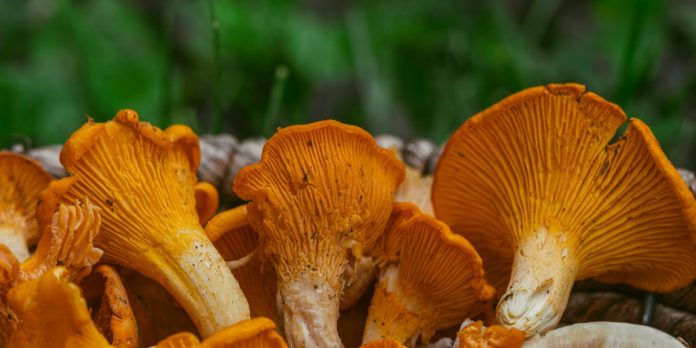Searching for chanterelles this season?
Prized for their rich and delicate flavor, these mouthwatering mushrooms are sure to be the mycological highlight of your day — if you manage to find and ID them correctly.
To help you get started, I’ve compiled a comprehensive guide to chanterelle mushroom identification. Read on to discover my tricks for recognizing various species and distinguishing true chanterelles from common look-alikes in the field.
How to Identify Chanterelles
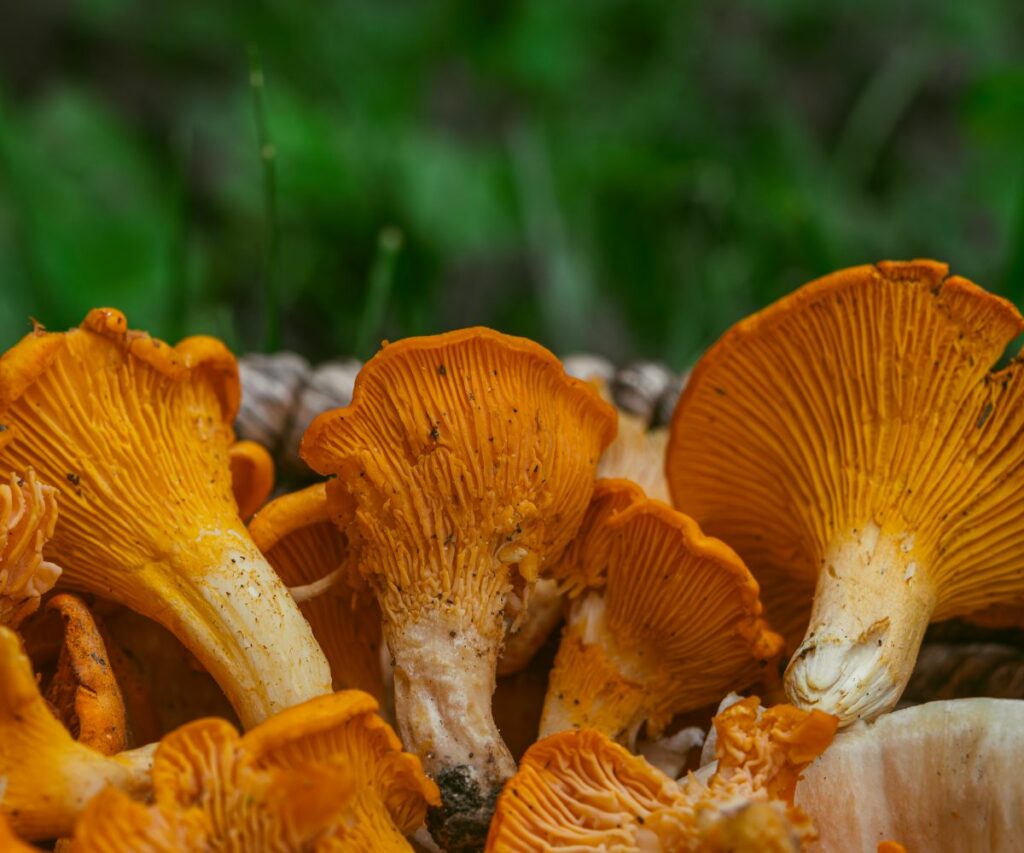
If you want your foraging basket to overflow with chanterelles, it’s crucial to identify them correctly. You’ll start by examining their appearance and texture, then move on to context clues, like habitat and growing conditions.
Appearance
Chanterelles are most often orange or yellow. They emerge from the ground in tiny pinpricks of color and grow quickly, with caps reaching 2–5” across and stalks normally maxing out at around 4” high. These are smaller edibles, so keep your eyes peeled. Even though they’re bright, you can easily miss them in the undergrowth.
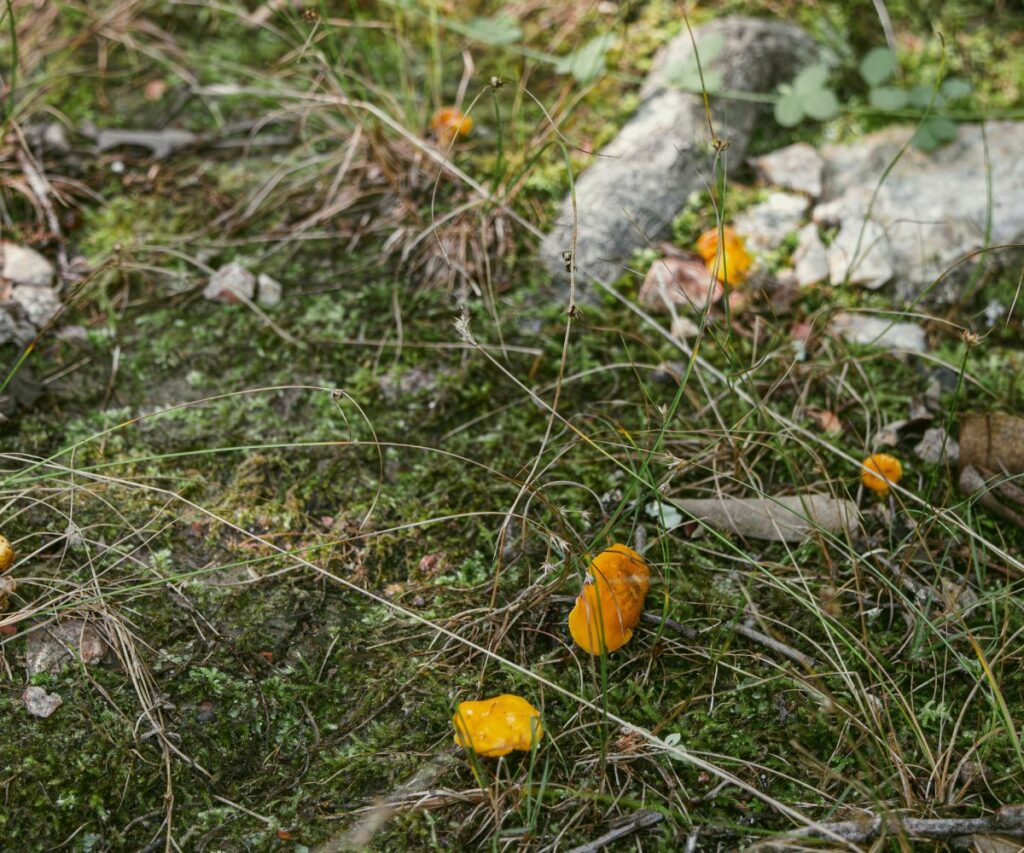
There are four distinct parts of the fungus we can examine to positively identify a chanterelle species:
- Cap: The cap is round when young but becomes trumpet or vase-shaped when fully mature, funneling down in the middle where the stalk attaches. The margins curl down as the mushroom grows and eventually become lobed.
- Pore surface: Chanterelles appear gilled, but don’t be fooled. They have false gills that do not fan or separate like true gills. They are more like ridges and may be wavy, straight, forked, or woven. They cover the underside of the cap and may extend downward, covering the top or middle parts of the stalk.
- Stalk: The stalk is usually short and may appear curved or bulge slightly on the bottom. The chanterelle does not have a true basal bulb like other species. It may be the same color as the cap and false gills, or differ slightly.
- Flesh: Chanterelle flesh is very pale or snow-white. Stems are solid, not hollow.
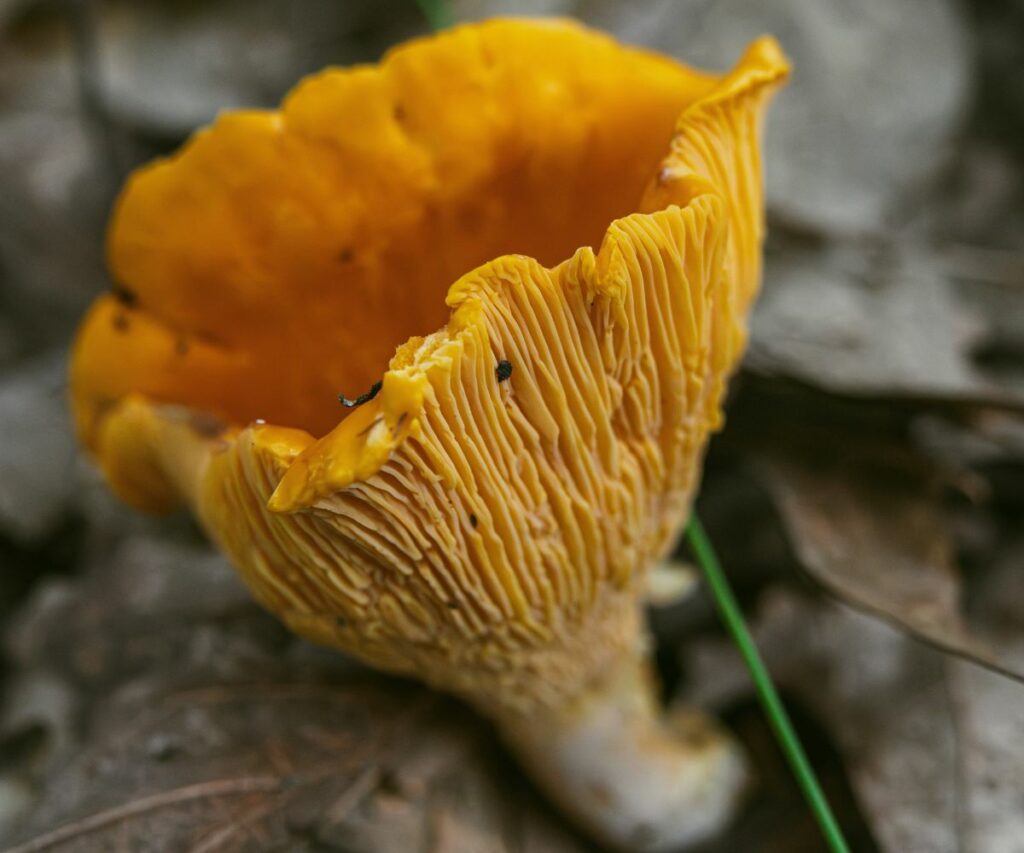
Species Variance
Let’s nerd out for a second.
Chanterelles are a basidiomycete belonging to the family Cantharellaceae. Until recently, we classified most common chanterelles as Cantharellus cibarius, but now we know that there are dozens of other species. Microscopic examination has revealed that Cantharellus cibarius doesn’t even occur in the US!
We currently refer to this group as the Cantharellus cibarius species complex.
So, why is this important to you? Different species have different appearances. You don’t want to pass up a perfectly good chanterelle because it has features you don’t instantly recognize.
Several common species with distinguishing characteristics have tripped me up in the past. You can learn from my mistakes by familiarizing yourself with the following:
- Cantharellus lateritius: Also known as “smooth chanterelle,” this species lacks false gills and has a smooth pore surface.
- Cantharellus subaldibus: Also known as the “white chanterelle,” this species has a white or pale pinkish cap. The pore surface and stem are still yellow.
- Cantharellus cinnabarinus: Also known as the “red chanterelle,” this species is dark to bright red. It is usually smaller than yellow varieties, with a round cap and longer, thinner stem.
- Cantharellus phasmatis: Often shorter and squatter than other varieties, this species is characterized by its white stalk.
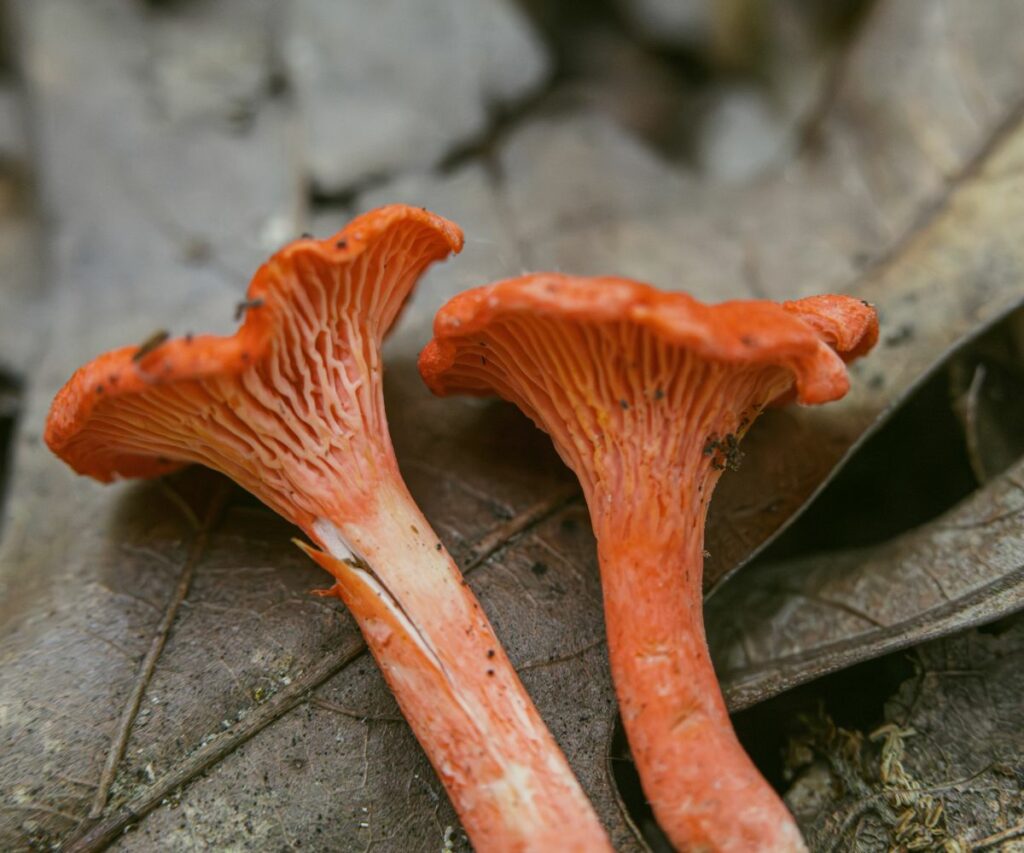
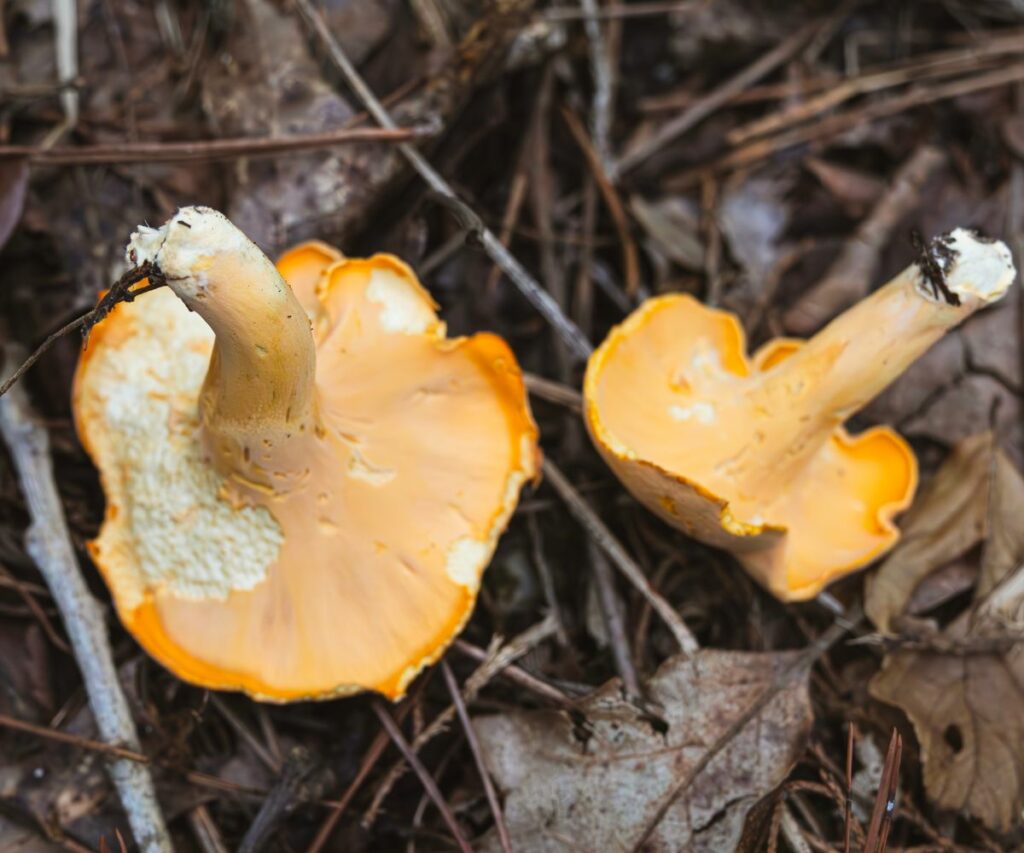
Texture
A chanterelle’s cap is smooth, soft, and may feel moist. It should give a little when you squish it but not disintegrate completely in your hands. Some species are more delicate than others, and the cap will break if you apply too much pressure. Always grab a chanterelle by the stalk to avoid damaging it.
If you’re new to identification, cut a single specimen in the field before you collect a whole flush. When you slice it, the white flesh inside will be delicate but solid. The texture is somewhat fibrous and will peel away as you scrape it with a fingernail.
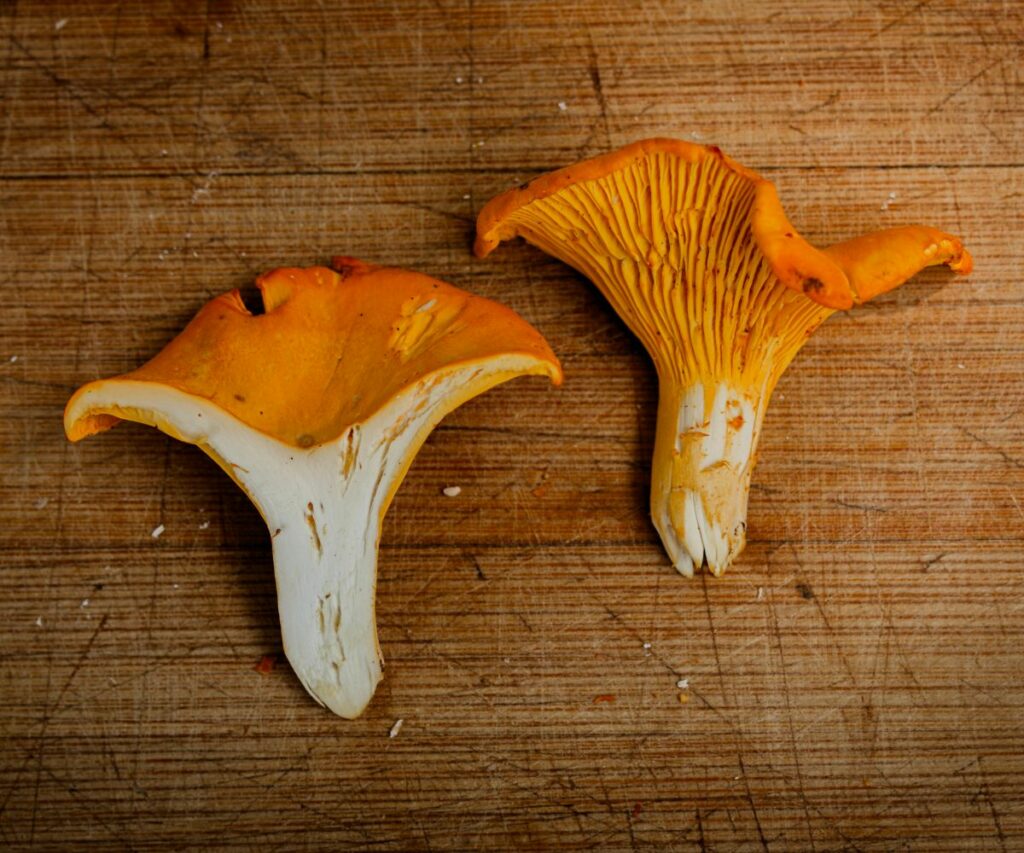
Chanterelles smell distinctly fruity, like apricots or peaches. Many people use scent as an identifier, which can help when you get up close and personal. However, it’s unlikely that your nose will lead you through the forest to a patch of chanterelles. It’s also worth noting that many other mushroom species have a fruity aroma, so you can’t rely on smell alone.
Habitat
Where does the chanterelle grow? Pretty much all over. Since different species thrive in various habitats, these beauties can be found in every state except Hawaii. There are region-specific species, such as Cantharellus formosus in the Pacific Northwest and Cantharellus appalachiensis in the eastern US. Still, it’s possible to find any species outside its comfort zone when conditions are perfect.
Chanterelles are mycorrhizal fungi that form a symbiotic relationship with plants’ root systems as part of their life cycle. Unlike decomposing saprobic fungi, such as wood ear or parasites like cordyceps, mycorrhizal fungi do not grow directly on another plant. So, if you think you see chanterelles on a log, you’re barking up the wrong tree.
Look to the ground instead. You’ll find them in old-growth hardwood forests at the base of living, healthy mycorrhizal trees. Oak, pine, poplar, and birch are among their favorites. Some chanterelles may sprout from moss, while others poke their heads up between fallen leaves. It’s common to see them clustered along trails beneath shady branches, but they may grow alone if the mood strikes them.
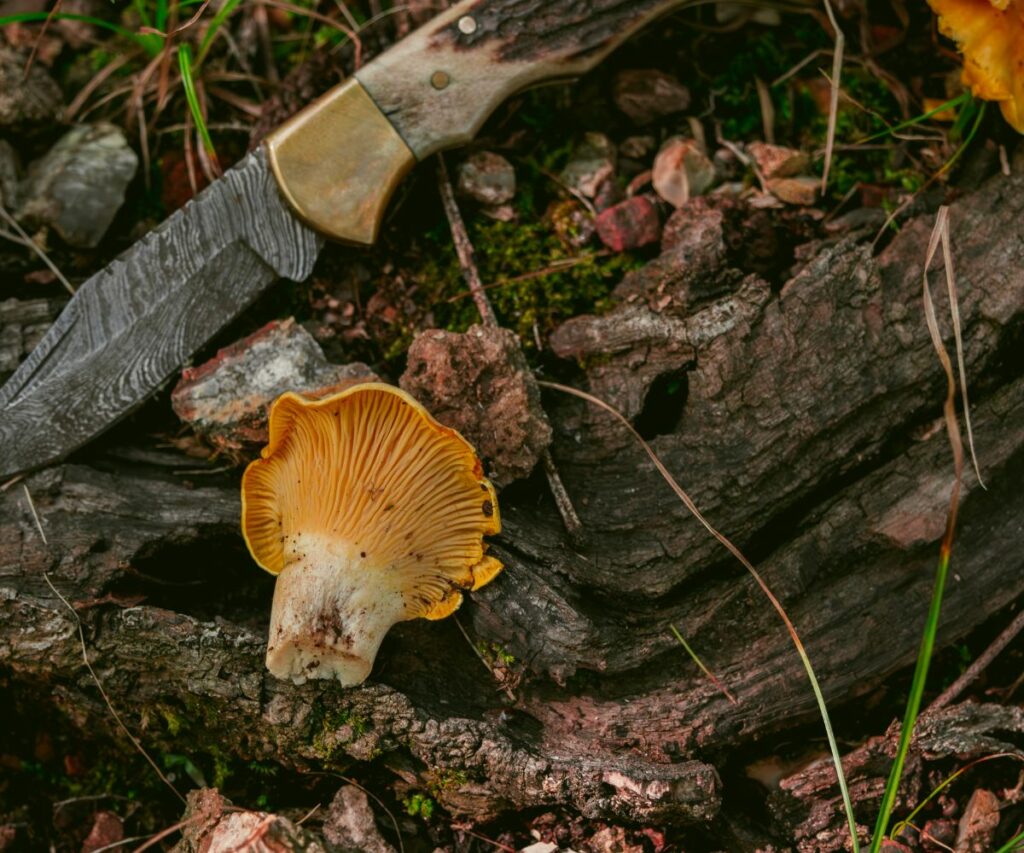
Growing Conditions and Seasons
While different chanterelle species thrive in different temperatures, all need moisture and some heat to grow. In my neck of the woods, the wet months of July and August are the most prolific for chanterelles, but they can appear anywhere from late spring to early fall.
Chanterelles often come up after heavy rains, followed by long periods of high humidity and steady heat. It seems that the hotter and wetter it is, the faster chanterelles will grow. Their reliance on the weather means they can be fickle, taking anywhere from a few days to several weeks to reach maturity. Some may take up to 90 days, but this is pretty rare — most appear within a week or so.
Unlike perseverant mushrooms such as turkey tail, chanterelles are finicky. They have a high moisture content and will wither and dry without water. You can’t really use them at this point, so time your forays correctly and strike while the iron is hot.
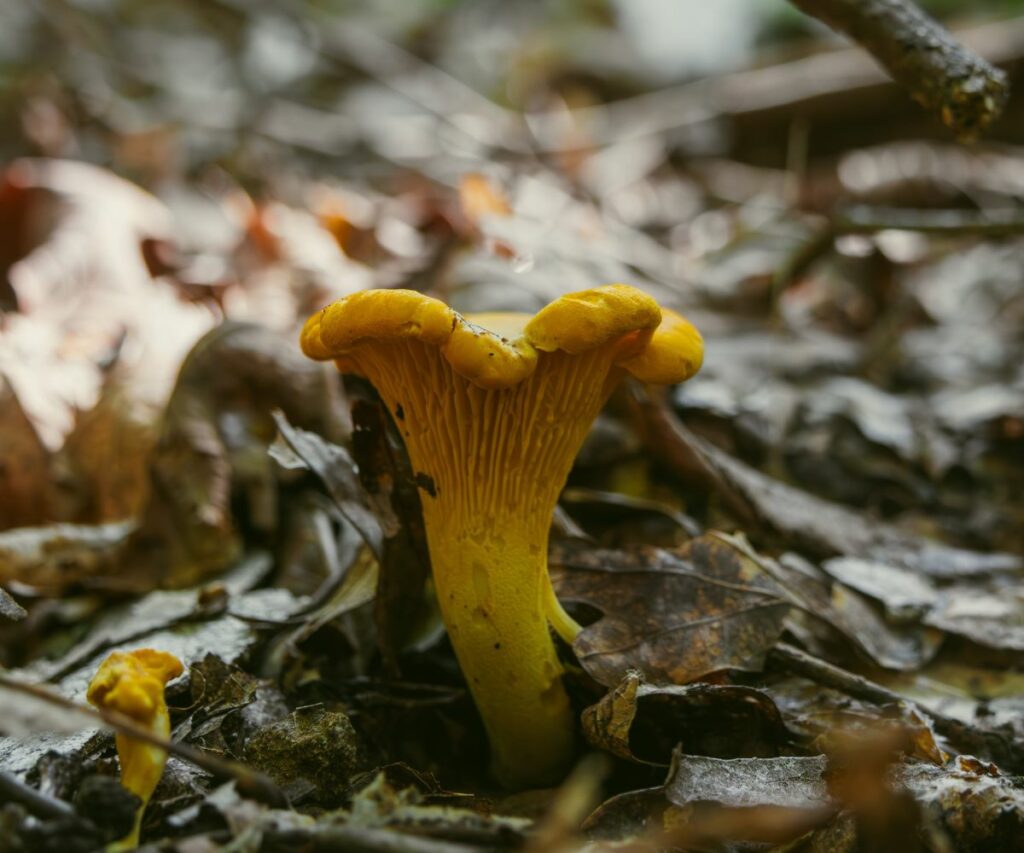
It’s important to note here that many refer to the species Craterellus tubaeformis as a “winter chanterelle.” Also known as trumpet mushrooms, these do appear in colder temperatures. While part of the Cantharellaceae family, trumpets belong to a different genus. Though delicious, they look, taste, and smell differently and are not true chanterelles.
Chanterelle Identification Checklist
- Bright yellow, orange, or red color
- Trumpet-shaped cap
- False gills
- Lobed margins
- Growing in warm season
- Growing on ground
- Fruity aroma
Recognizing Common Look-Alikes
There are no poisonous chanterelle species, but there are toxic look-alikes. Becoming familiar with them is critical so you don’t make a mistake down the road and wind up sick.
Jack-o-Lantern Mushroom
We might refer to any number of Omphalotus species as jack-o-lantern mushrooms. Beautiful but unfortunately toxic, it’s easy for the untrained eye to mix them up with chanterelles. They share many of the same features, with bright orange caps, gilled undersides, and a classic funnel shape.
It’s possible to distinguish them from a distance by examining their growing conditions. Jack-o-lanterns are saprobic and often grow directly on tree bases or downed logs. They sprout in clusters from a single stalk base, while chanterelles usually fly solo. Jacks also have true gills that separate easily, fanning out when touched. They can grow much larger than chanterelles, and their flesh is orange when cut.
If you find it: Don’t harvest or consume it, but don’t get scared away. Jack-o-lanterns are fabulous fungi that get a bad rap because people keep eating them. Many contain bioluminescence and glow in the dark, so return to your jack patch when the sun goes down and catch a cool light show.
False Chanterelle
There’s a reason we call Hygrophoropsis aurantiaca the “false chanterelle.” This little yellow shroom is a proper deceiver, popping up on the forest floor in the same areas real chanterelles may appear. With a similar trumpet shape and gilled underside, it can be challenging to distinguish them.
However, a quick look under the cap will usually set you straight. False chanterelles have true gills, which do not cross or fork. The cap is more round than lobed, and cutting one open will reveal a hollow stem and pale orange flesh. False chanterelles are generally weak and flimsy fungi. Touching one is usually enough to distinguish it from the firmer chanterelle.
If you find it: Leave it alone. While some people report eating false chanterelles without ill effects, others report mild to severe gastrointestinal distress. No one has reported a cool light show.
Wooly Chanterelle
Known in the scientific community as Turbinellus floccosus, the wooly or “scaly” chanterelle may trip up novice foragers. It boasts the same orange cap with a trumpet shape and even has false gills like the real deal. But the similarities end upon further examination.
The wooly chanterelle has a scaly top with textural variations and different color tones. Its cap is deeper and broader, and its false gills are shallower. They can get very dense and toothy or stay thinner, resembling the wrinkled ridges of textured drywall.
If you find it: Leave it alone. While the wooly chanterelle is considered a choice edible in Mexico and India, those growing in North America are genetically different. They can cause stomach pain, nausea, and vomiting.
Feeling hungry? All this talk about mushrooms probably has you craving them. Now that you know how to identify chanterelles, you’re ready to hit the trail and forage some fungus for dinner!

